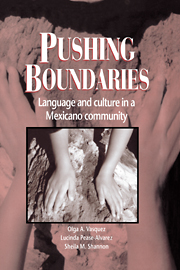Book contents
- Frontmatter
- Contents
- Foreword
- Preface
- Chapter 1 INTRODUCTION
- Chapter 2 EASTSIDE: A MEXICANO COMMUNITY
- Chapter 3 HOME AND SCHOOL CONTEXTS FOR LANGUAGE LEARNING
- Chapter 4 BILINGUAL CHILDREN CROSSING CULTURAL BORDERS
- Chapter 5 NEGOTIATING CULTURE AND LANGUAGE IN THE HOME
- Chapter 6 MOVING TOWARD A RECOGNITION PERSPECTIVE
- Chapter 7 MEETING THE CHALLENGES OF DIVERSITY
- Notes
- References
- Index
Chapter 3 - HOME AND SCHOOL CONTEXTS FOR LANGUAGE LEARNING
Published online by Cambridge University Press: 26 March 2010
- Frontmatter
- Contents
- Foreword
- Preface
- Chapter 1 INTRODUCTION
- Chapter 2 EASTSIDE: A MEXICANO COMMUNITY
- Chapter 3 HOME AND SCHOOL CONTEXTS FOR LANGUAGE LEARNING
- Chapter 4 BILINGUAL CHILDREN CROSSING CULTURAL BORDERS
- Chapter 5 NEGOTIATING CULTURE AND LANGUAGE IN THE HOME
- Chapter 6 MOVING TOWARD A RECOGNITION PERSPECTIVE
- Chapter 7 MEETING THE CHALLENGES OF DIVERSITY
- Notes
- References
- Index
Summary
Yo hago cosas que ayudan a mi hijo a desarrollar su lenguaje. Le nombro los productos que encontramos en la tienda. Le doy palabritas que no sabe cuando expresa sus ideas. Y siempre conversamos.
Rosa HernandezI do things that help my son to develop his language. I name the products that we find at the store. I tell him words that he doesn't know when he expresses his ideas. And we always talk.
In the preceding quote, Rosa Hernandez, a Mexican immigrant from a working-class background, recounts a common theme in the literature on children's language development: language learning as a negotiated activity. This perspective is routinely supported using evidence from studies on the language-learning environments available to middle-class, English-speaking students. These studies portray middle-class homes as places where parents initiate conversations with their children and adjust their own conversation to make it more accessible to their children. They elicit clarifications and elaborations, expand and extend children's utterances, and regularly engage children in predictable conversational routines (Brown and Bellugi, 1964; Ratner and Bruner, 1977; Ninio and Bruner, 1977; Snow, 1977, 1983; Cazden, 1979; Scollon and Scollon, 1981). Evidence from ethnographic research suggests that the language learning environment of ethnic minority children from working-class populations living in the United States is quite different from that of white middle-class children. In the minority communities authors such as Miller (1982), Heath (1983), Boggs (1985), and Philips (1983) studied, adults didn't engage children in extended conversations or accommodate their speech to their children's developmental level.
- Type
- Chapter
- Information
- Pushing BoundariesLanguage and Culture in a Mexicano Community, pp. 46 - 79Publisher: Cambridge University PressPrint publication year: 1994



